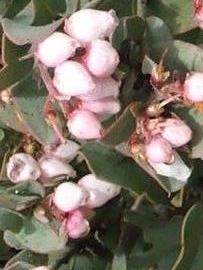Pecho manzanita
(Arctostaphylos pechoensis)

Description
Arctostaphylos pechoensis is a species of manzanita known by the common name Pecho manzanita. It is endemic to California, where it is known only from the Pecho Hills southwest of San Luis Obispo in San Luis Obispo County, California. It is a plant of the chaparral and coastal coniferous forest. This is a large shrub, generally growing at least 2 meters tall and known to exceed five meters in height. Its smaller branches are woolly with long white bristles. The dense foliage of leaves are oval-shaped, smooth, toothed, or jagged along the edges, and overlapping. The inflorescence is a cluster of cone-shaped manzanita flowers, each about 7 millimeters long. The fruit is a hairless or nearly hairless red drupe about a centimeter wide. Arctostaphylos is a genus of plants comprising the manzanitas and bearberries. They are shrubs or small trees. There are about 60 species, of Arctostaphylos, ranging from ground-hugging arctic, coastal, and mountain species to small trees up to 6 m tall. Most are evergreen (one species deciduous), with small oval leaves 1–7 cm long, arranged spirally on the stems. The flowers are bell-shaped, white or pale pink, and borne in small clusters of 2–20 together; flowering is in the spring. The fruit are small berries, ripening in the summer or autumn. The berries of some species are edible. Arctostaphylos species are used as food plants by the larvae of some Lepidoptera species including Coleophora arctostaphyli (which feeds exclusively on A. uva-ursi) and Coleophora glaucella. Manzanitas, the bulk of Arctostaphylos species, are present in the chaparral biome of western North America, where they occur from southern British Columbia in Canada, Washington to California and New Mexico in the United States, and throughout much of northern and central Mexico. Three species, the bearberries, A. alpina (alpine bearberry), A. rubra (red bearberry) and A. uva-ursi (common bearberry), have adapted to arctic and subarctic climates, and have a circumpolar distribution in northern North America, Asia and Europe. An unusual association of manzanita occurs on Hood Mountain, in Sonoma County, California, where stands of pygmy forest dominated by Mendocino cypress are found.
Taxonomic tree:







